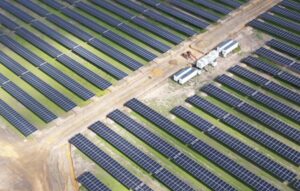 The Victorian Labor Party has sought to underline its renewable energy credentials by vowing to help the town of Newstead, near Bendigo, to become 100 per cent renewable energy by 2017, and become the state’s first “solar town”.
The Victorian Labor Party has sought to underline its renewable energy credentials by vowing to help the town of Newstead, near Bendigo, to become 100 per cent renewable energy by 2017, and become the state’s first “solar town”.
The commitment comes a few days after party led by Daniel Andrews said that a Labor Government would reverse the wind farm restrictions imposed by the Coalition state government, and seek to unlock billions of dollars in stalled investment.
The focus on Newstead, a town of just over 500 people on the Loddon River about 55kms from Bendigo, and 120kms north west of Melbourne, is interesting because Labor says it will focus primarily on solar power and battery storage to become 100 per cent renewable.
Labor says it will committ $200,000 of grant funding to help the local community group behind the project to draw up a master plan. Shadow Minister for Energy and Resources, Lily D’Ambrosio, also said Labor will ensure small renewable energy projects can have fair access to the existing grid.
She said Labor will also ask the Essential Services Commission to inquire into the true value to the grid of distributed generation, and seek to ensure that distribution businesses are more responsive to distributed energy proposals.
“Labor will also ensure that energy retailers cannot discriminate against rooftop solar customers by charging extra supply fees,” it said, which will put it on an interesting path against the distributors who have been looking to increase fixed charges on solar households, as has happened in other states.
Newstead is not the only town seeking to go 100 per cent renewable. Yackandandah is also seeking to go entirely renewable by 2022, and its Totally Renewable Yackandandah campaign will be officially launched next week.
The Newstead initiative is led by Renewable Newstead, which wants it to become a town where “people talk and thing about energy and where understanding of our usage and our energy options become widespread in the community.”
“Newstead will be a leading example of what can be achieved when locals and government work together,” D’Ambrosio said in a statement. “Not only will the residents in Newstead reduce their reliance on coal fired power and cut their carbon footprint, they will be driving down household costs through cheaper energy bills.”
Environment Victoria said the initiate would create a valuable template that can be rolled-out across the state, and welcomed Labor’s commitment to ensure fair access, and fair prices, for rooftop solar.
“The ALP’s commitment to removing barriers faced by small renewable energy projects is a positive step for Victoria,” it said. “Where a community has the motivation to transition towards renewable energy, the Government needs to ensure that there are no regulatory obstacles in the way.”
On solar it said: “Owners of solar PV can only sell their electricity to retailers for 8 c/kWh, but retailers are then on-selling this same electricity for around 25 c/kWh. Once we understand the true value of this clean electricity, a fair price needs to be paid to those who generate it.”
However, it said Labor was yet to indicate the extent of its overall renewable energy and emissions reductions targets, and what plans it had for the ageing, polluting brown coal generators.
Friends of the Earth campaigner Leigh Ewbank agreed that the state needed a state-based renewable energy target. He said towns such as Newstead and Yackandandah were “sending a clear message to the state government and opposition when it comes to our energy future.”
“With the G20 showing loud and clear that the rest of the world is taking climate change seriously, it is critical that the next Victorian Government position our state at the forefront of the global energy revolution.”










